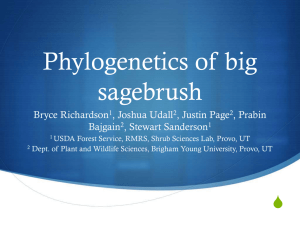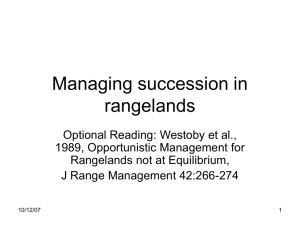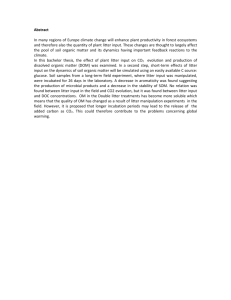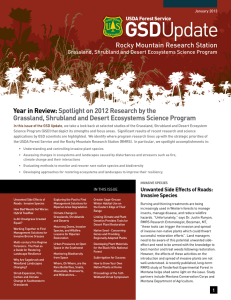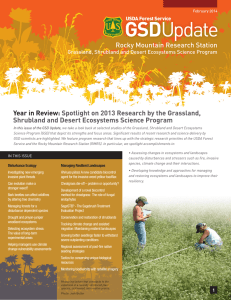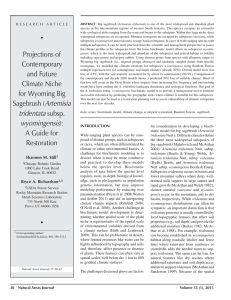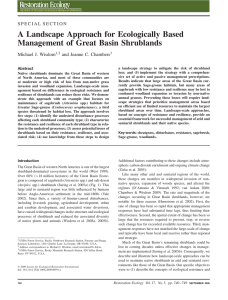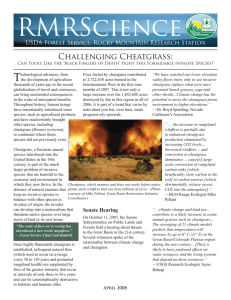ANNOUNCING NEW PUBLICATIONS AND SAGE-GROUSE CONSERVATION
advertisement
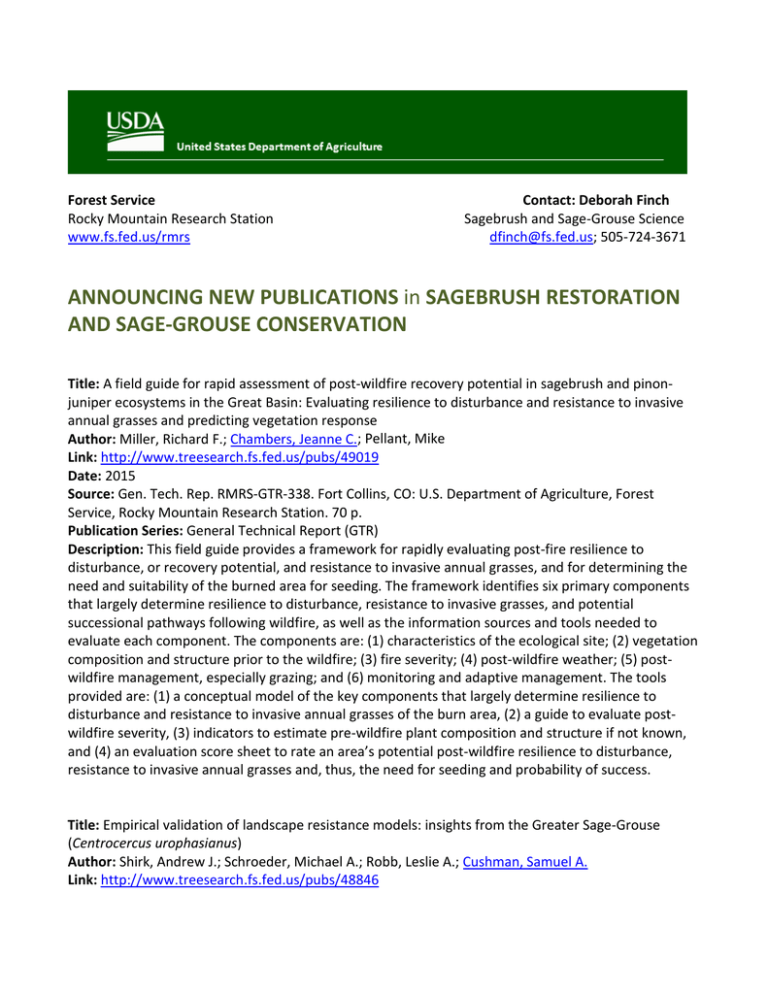
Forest Service Rocky Mountain Research Station www.fs.fed.us/rmrs Contact: Deborah Finch Sagebrush and Sage-Grouse Science dfinch@fs.fed.us; 505-724-3671 ANNOUNCING NEW PUBLICATIONS in SAGEBRUSH RESTORATION AND SAGE-GROUSE CONSERVATION Title: A field guide for rapid assessment of post-wildfire recovery potential in sagebrush and pinonjuniper ecosystems in the Great Basin: Evaluating resilience to disturbance and resistance to invasive annual grasses and predicting vegetation response Author: Miller, Richard F.; Chambers, Jeanne C.; Pellant, Mike Link: http://www.treesearch.fs.fed.us/pubs/49019 Date: 2015 Source: Gen. Tech. Rep. RMRS-GTR-338. Fort Collins, CO: U.S. Department of Agriculture, Forest Service, Rocky Mountain Research Station. 70 p. Publication Series: General Technical Report (GTR) Description: This field guide provides a framework for rapidly evaluating post-fire resilience to disturbance, or recovery potential, and resistance to invasive annual grasses, and for determining the need and suitability of the burned area for seeding. The framework identifies six primary components that largely determine resilience to disturbance, resistance to invasive grasses, and potential successional pathways following wildfire, as well as the information sources and tools needed to evaluate each component. The components are: (1) characteristics of the ecological site; (2) vegetation composition and structure prior to the wildfire; (3) fire severity; (4) post-wildfire weather; (5) postwildfire management, especially grazing; and (6) monitoring and adaptive management. The tools provided are: (1) a conceptual model of the key components that largely determine resilience to disturbance and resistance to invasive annual grasses of the burn area, (2) a guide to evaluate postwildfire severity, (3) indicators to estimate pre-wildfire plant composition and structure if not known, and (4) an evaluation score sheet to rate an area’s potential post-wildfire resilience to disturbance, resistance to invasive annual grasses and, thus, the need for seeding and probability of success. Title: Empirical validation of landscape resistance models: insights from the Greater Sage-Grouse (Centrocercus urophasianus) Author: Shirk, Andrew J.; Schroeder, Michael A.; Robb, Leslie A.; Cushman, Samuel A. Link: http://www.treesearch.fs.fed.us/pubs/48846 Date: 2015 Source: Landscape Ecology. doi: 10.1007/s10980-015-0214-4. Publication Series: Scientific Journal (JRNL) Description: The ability of landscapes to impede species’ movement or gene flow may be quantified by resistance models. Few studies have assessed the performance of resistance models parameterized by expert opinion. In addition, resistance models differ in terms of spatial and thematic resolution as well as their focus on the ecology of a particular species or more generally on the degree of human modification of the landscape (i.e. landscape integrity). The effect of these design decisions on model accuracy is poorly understood. Title: Projections of contemporary and future climate niche for Wyoming big sagebrush (Artemisia tridentata subsp. wyomingensis): A guide for restoration Author: Still, Shannon M.; Richardson, Bryce A. Link: http://www.treesearch.fs.fed.us/pubs/48015 Date: 2015 Source: Natural Areas Journal. 35(1): 30-43. Publication Series: Scientific Journal (JRNL) Description: Big sagebrush (Artemisia tridentata) is one of the most widespread and abundant plant species in the intermountain regions of western North America. This species occupies an extremely wide ecological niche ranging from the semi-arid basins to the subalpine. Within this large niche, three widespread subspecies are recognized. Montane ecoregions are occupied by subspecies vaseyana, while subspecies wyomingensis and tridentata occupy basin ecoregions. In cases of wide-ranging species with multiple subspecies, it can be more practical from the scientific and management perspective to assess the climate profiles at the subspecies level. We focus bioclimatic model efforts on subspecies wyomingensis, which is the most widespread and abundant of the subspecies and critical habitat to wildlife including sage-grouse and pygmy rabbits. Using absence points from species with allopatric ranges to Wyoming big sagebrush (i.e., targeted groups absences) and randomly sampled points from specific ecoregions, we modeled the climatic envelope for subspecies wyomingensis using Random Forests multiple-regression tree for contemporary and future climates (decade 2050). Overall model error was low, at 4.5%, with the vast majority accounted for by errors in commission (>99.9%). Comparison of the contemporary and decade 2050 models shows a predicted 39% loss of suitable climate. Much of this loss will occur in the Great Basin where impacts from increasing fire frequency and encroaching weeds have been eroding the A. tridentata landscape dominance and ecological functions. Our goal of the A. tridentata subsp. wyomingensis bioclimatic model is to provide a management tool to promote successful restoration by predicting the geographic areas where climate is suitable for this subspecies. This model can also be used as a restoration-planning tool to assess vulnerability of climatic extirpation over the next few decades. Title: Insights into transcriptomes of Big and Low sagebrush Author: Huynh, Mark D.; Page, Justin T.; Richardson, Bryce A.; Udall, Joshua A.; Link: http://www.treesearch.fs.fed.us/pubs/48949 Date: 2015 Source: PLoS ONE. doi: 10.1371/journal.pone.0127593.s001. Publication Series: Scientific Journal (JRNL) Description: We report the sequencing and assembly of three transcriptomes from Big (Artemisia tridentatassp. wyomingensis and A. tridentate ssp. tridentata) and Low (A. arbuscula ssp. arbuscula) sagebrush. The sequence reads are available in the Sequence Read Archive of NCBI. We demonstrate the utilities of these transcriptomes for gene discovery and phylogenomic analysis. An assembly of 61,883 transcripts followed by transcript identification by the program TRAPID revealed 16 transcripts directly related to terpene synthases, proteins critical to the production of multiple secondary metabolites in sagebrush. A putative terpene synthase was identified in two of our sagebrush samples. Using paralogs with synonymous mutations we reconstructed an evolutionary time line of ancient genome duplications. By applying a constant mutation rate to the data we estimate that these three ancient duplications occurred about 18, 34 and 60 million years ago. These transcriptomes offer a foundation for future studies of sagebrush, including inferences in chemical defense and the identification of species and subspecies of sagebrush for restoration and preservation of the greater sage-grouse. Title: Genecological approaches to predicting the effects of climate change on plant populations Author: Kilkenny, Francis F. Link: http://www.treesearch.fs.fed.us/pubs/47748 Date: 2015 Source: Natural Areas Journal. 35(1):152-164. Publication Series: Scientific Journal (JRNL) Description: Climate change threatens native plant populations and plant communities globally. It is critical that land managers have a clear understanding of climate change impacts on plant species and populations so that restoration efforts can be adjusted accordingly. This paper reviews the develop.ment and use of seed transfer guidelines for restoration in the face of global climate change, with an emphasis on the role of common garden studies in predicting climate change impacts. A method is presented for using genecological common garden data to assess population vulnerability to changing environmental conditions that includes delineation of geographical regions where habitats are likely to become marginal, assessment of shifting climatic selection pressures on plant traits, and identification of source material that is likely to be adapted to changing conditions. This method is illustrated using a genecological dataset for bluebunch wheatgrass (Pseudoroegneria spicata). The demonstration indicates that bluebunch populations will be vulnerable to extirpation in areas of their current range, that selection pressures will increase on a trait important to climatic adaptation, and that promising seed sources exist that may be able to persist under novel conditions. Additional avenues for expansion of the presented methods are discussed, and the use of common garden data for management in the context of evolution and changing climates is considered. Title: The role of resource limitation in restoration of sagebrush ecosystems dominated by cheatgrass (Bromus tectorum) Author: Jones, Rachel O.; Chambers, Jeanne C.; Board, David I.; Johnson, Dale W.; Blank, Robert R. Link: http://www.treesearch.fs.fed.us/pubs/48645 Date: 2015 Source: Ecosphere. 6(7): Article 107. Publication Series: Scientific Journal (JRNL) Description: Success of invasive annual grasses is often linked to increases in resources, and restoration ecologists have suggested that decreasing nitrogen (N) availability and restoring more conservative N cycles with lower N turnover should decrease the competitive advantage of these invaders and facilitate establishment of native perennials. We developed a multivariate conceptual model of the likely effects of environmental factors (precipitation and temperature) and potential management treatments (repeated burning, litter manipulation, and seeding an annual competitor) on soil N availability and success of cheatgrass, the most widespread invader in the western United States. We examined effects of the treatments in a five year field study in a cold desert shrubland. We used generalized linear mixed-effects models to examine differences among treatments over time, and structural equation modeling (SEM) to evaluate component hypotheses of the conceptual model. We hypothesized that burning would result in a pulse in soil available N due to heat-induced soil organic matter denaturation, but that subsequent fires would volatilize soil and biomass N resulting in progressive N deficiency. However, soil available N in burned plots was never lower than pre-burn levels, likely because burn temperatures were too cool to volatilize N from soils or aboveground biomass. Repeated burning decreased litter biomass, but there were generally no differences in soil available N between litter intact and litter removed plots. Litter removal had a negative effect on cheatgrass success likely due to effects on seed entrapment and plant establishment rather than N mineralization. Plots seeded with wheat generally had the lowest cheatgrass success, but available N was similar to other treatments, and decreased cheatgrass success was likely due to competition for other soil nutrients or water and reduced litter. In this semi-arid shrubland, long-term trends in available soil N and cheatgrass success were most strongly associated with precipitation and winter minimum temperatures. Treatments did not result in longer-term decreases in soil N, but indicated that integrated restoration approaches that reduce litter and seed banks and increase competitive interactions may be effective at reducing cheatgrass success and facilitating establishment of natives. Title: Functionally relevant climate variables for arid lands: Aclimatic water deficit approach for modelling desert shrub distributions Author: Dilts, Thomas E.; Weisberg, Peter J.; Dencker, Camie M.; Chambers, Jeanne C. Link: http://www.treesearch.fs.fed.us/pubs/48739 Date: 2015 Source: Journal of Biogeography. doi: 10.1111/jbi.12561 Publication Series: Scientific Journal (JRNL) Description: We have three goals. (1) To develop a suite of functionally relevant climate variables for modelling vegetation distribution on arid and semi-arid landscapes of the Great Basin, USA. (2) To compare the predictive power of vegetation distribution models based on mechanistically proximate factors (water deficit variables) and factors that are more mechanistically removed from a plant’s use of water (precipitation). (3) To quantify the climate gradients that control shrub distributions in a cold desert environment. Title: Effect of repeated burning on plant and soil carbon and nitrogen in cheatgrass (Bromus tectorum) dominated ecosystems Author: Jones, Rachel; Chambers, Jeanne C.; Johnson, Dale W.; Blank, Robert R.; Board, David I. Link: http://www.treesearch.fs.fed.us/pubs/48654 Date: 2015 Source: Plant Soil. 386: 47-64. Publication Series: Scientific Journal (JRNL) Description: Fire has profound effects on ecosystem properties, but few studies have addressed the effect of repeated burns on soil nutrients, and none have been conducted in cold desert ecosystems where invasion by exotic annual grasses is resulting in greater fire frequency. In a 5 year study, we examined effects of repeated burning, litter removal, and post-fire seeding on carbon (C) and nitrogen (N) contents in soils, litter, and vegetation in a cheatgrass-dominated Wyoming big sagebrush ecological type. We developed a multivariate model to identify potential mechanisms influencing treatment effects and examine the influence of environmental factors such as precipitation and temperature. We found that repeated burning had strong negative effects on litter C and N contents, but did not reduce soil nutrients or vegetation C and N contents, likely due to cool fire temperatures. There were few effects of litter removal or post-fire seeding. Instead, precipitation and temperature interacted with burning and had the strongest influences on soil N and vegetation C and N contents over time. Management strategies aimed at decreasing litter and seed banks and increasing competitive interactions may be more effective at reducing cheatgrass success than approaches for reducing soil nutrients. Title: Review of Native Plant Material Development and Use in the Sagebrush Steppe of North America. Link: http://www.cambridgescholars.com/guidelines-for-native-seed-production-and-grasslandrestoration Authors: Nancy Shaw; Scott Jensen Date: 2014 Source: Cambridge Scholars Publishing Publication Series: Book Chapter Description: Shaw and Jensen present results from restoration projects that aim to restore native communities on semi-arid lands. They conclude that restoration strategies have to take into account recent research on seed zones and native seed production, interactions of native and invasive species, and technologies for reestablishing native communities in order to enhance restoration success. Title: USDA Forest Service Sage-Grouse Conservation Science Strategy Author: Finch, Deborah; Boyce, Douglas; Chambers, Jeanne; Colt, Chris; McCarthy, Clint; Kitchen, Stanley; Richardson, Bryce; Rowland, Mary; Rumble, Mark; Schwartz, Michael; Tomosy, Monica; Wisdom, Michael; Link: http://www.treesearch.fs.fed.us/pubs/48644 Date: 2015 Source: Washington, DC: U.S. Department of Agriculture, Forest Service. 39 p. Publication Series: Miscellaneous Description: Numerous federal and state agencies, research institutions and stakeholders have undertaken tremendous conservation and research efforts across 11 States in the western United States to reduce threats to Greater Sage-Grouse (Centrocercus urophasianus) and sagebrush (Artemisia spp) habitats. In 2010, the U.S. Fish and Wildlife Service (USFWS) determined that the Greater SageGrouse was warranted for protection under the Endangered Species Act, but that action was precluded by higher priority listing actions. As part of a 2011 court settlement, USFWS agreed to make an initial determination on whether to propose the species for listing by September 30, 2015 fiscal year. The Draft FY 2015 Omnibus Appropriations Bill contains a rider that currently prevents USFWS from publishing a proposed listing rule regarding greater sage-grouse, but it does not relieve USFWS of its obligation to determine whether the species still warrants protection under the ESA. Consequently, USFWS is moving forward with a determination by the end of 2015. The Service also found that the bistate population of Greater Sage-Grouse bordering California and Nevada, considered a distinct population segment (DPS), also warranted protection as a threatened species under ESA (Federal Register 2013). The Rocky Mountain Research Station is one of seven regional units that make up the U.S. Forest Service Research and Development organization – the most extensive natural resources research organization in the world. The Station maintains 12 field laboratories throughout a 12-state territory encompassing the Great Basin, Southwest, Rocky Mountains, and parts of the Great Plains, and administers and conducts research on 14 experimental forests, ranges, and watersheds, while maintaining long-term databases for these areas. RMRS research is broken into seven science program areas that serve the Forest Service as well as other federal and state agencies, international organizations, private groups and individuals. To find out more about the RMRS go to www.fs.fed.us/rmrs. You can also follow us on Twitter at www.twitter.com/usfs_rmrs.
